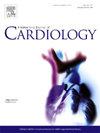Intravascular lithotripsy in calcified left main coronary artery: Procedural success and 1-year clinical outcomes
IF 3.2
2区 医学
Q2 CARDIAC & CARDIOVASCULAR SYSTEMS
引用次数: 0
Abstract
Background
Intravascular lithotripsy (IVL) has an excellent efficacy and safety profile in the treatment of calcified coronary lesions during percutaneous coronary intervention (PCI). However, data regarding its use on left main (LM) lesions are still limited.
Objective
We aimed to analyze the technical success and 1-year clinical outcomes in calcified LM lesions treated with IVL.
Methods
Patients who underwent IVL from the ongoing prospective BENELUX registry were eligible for inclusion. Patients were divided into LM and non-LM groups based on the anatomical application of the IVL pulses. The primary technical endpoint was technical success, defined as the successful delivery of the IVL catheter across the target lesion, administration of IVL pulses without angiographic complications, and achieving a residual target lesion stenosis of less than 30 %. The primary safety endpoint was in-hospital major adverse cardiac events (MACE).
Results
The study included 509 patients (59 LM and 450 non-LM). Patients in the LM group were significantly older (79 years [75–82] vs. 73 years [68–81], p < 0.01). Left ventricular ejection fraction was slightly lower in the LM group (41 % [19–50] vs. 51 % [40–60], p = 0.053). Temporary mechanical circulatory support devices were more frequently used in the LM group, primarily as part of the “protected PCI” strategy (6.8 % in LM vs. 2.1 % in non-LM, p = 0.04). Technical success was comparable between the two groups (93.2 % in LM vs. 89.8 % in non-LM, p = 0.41). Cardiac death, MACE, and target vessel revascularization rates were also comparable at hospital discharge, 30 days, and 1-year follow-up.
Conclusion
IVL in calcified LM lesions achieved comparable technical success and long-term clinical outcomes to non-LM lesions.
求助全文
约1分钟内获得全文
求助全文
来源期刊

International journal of cardiology
医学-心血管系统
CiteScore
6.80
自引率
5.70%
发文量
758
审稿时长
44 days
期刊介绍:
The International Journal of Cardiology is devoted to cardiology in the broadest sense. Both basic research and clinical papers can be submitted. The journal serves the interest of both practicing clinicians and researchers.
In addition to original papers, we are launching a range of new manuscript types, including Consensus and Position Papers, Systematic Reviews, Meta-analyses, and Short communications. Case reports are no longer acceptable. Controversial techniques, issues on health policy and social medicine are discussed and serve as useful tools for encouraging debate.
 求助内容:
求助内容: 应助结果提醒方式:
应助结果提醒方式:


